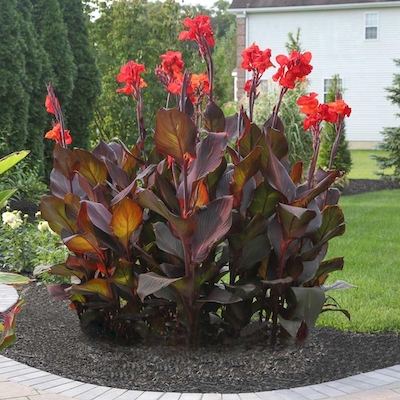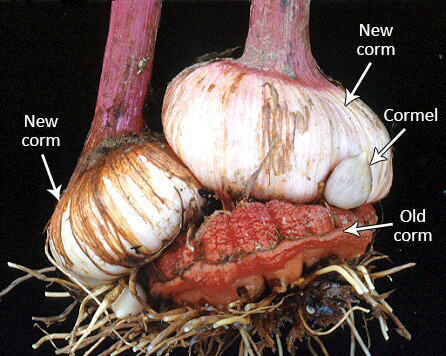Saving and Storing Tropicals for Next Year
By Ray Novitske, Fairfax Master Gardener
 Us cheap gardeners hate to spend a lot of money on plants and hate to throw any away. Like a well-worn pair of comfortable sneakers, I hold on to plants as long as possible, getting the most use out of them. This is especially true of summer tropicals — especially those that form bulbs that can be stored in the winter without any care on my part.
Us cheap gardeners hate to spend a lot of money on plants and hate to throw any away. Like a well-worn pair of comfortable sneakers, I hold on to plants as long as possible, getting the most use out of them. This is especially true of summer tropicals — especially those that form bulbs that can be stored in the winter without any care on my part.
We can try to keep tropical plants growing indoors, but many don’t like the shorter days, low light levels and dry air. There’s also the insects hitchhiking on the plants when you bring them indoors. And, some naturally prefer a dormant stage. To enjoy the tropicals next year, we can spend time moving them indoors and nursing them along through the winter, or just dig up the underground parts, store them indoors for the winter and bring them back to life again in the spring.
Not all tropical plants produce the bulbs that can be stored. The term ‘bulbs’ used here is a generic term for the underground parts we can overwinter. Some of these parts are scientifically classified as bulbs, but others are actually corms, rhizomes or tubers.
Bulbs are storage organs but considered as fully complete plants; they contain cells for all parts of the plant — roots, leaves, stems, flowers. Rhizomes are actually underground stems that send out shoots and roots. Corms are underground stems but are also storage devices to keep nutrients for when the plant will need it. And finally, tubers are not stems but underground organs for storing energy and nutrients.
Here are some of the more common tropical plants that we can lift and take indoors:

Gladiolus corms
Gladiolus and tuberous begonias
Gladiolus can be left in the garden well after frost and removed as late as October or November. First, dig up the corms. After letting them dry out for a week or two, brush off the dried soil. Remove the older shriveled portions, leaving the new corms that formed during the summer. Place in a paper or mesh bag — I have used a cardboard box. Do not place in plastic bags, as moisture will build up and promote rot during the winter. Store in a cool, dry and dark place until ready for planting again in the spring when danger of frost has passed.
Dahlia
Dig up dahlia tubers just after the frost when the leaves have turned black. Cut off the stems and rinse tubers in water to remove the loose soil from around each and allow to sit in a warm dry place for a week or two. Dahlias should be stored in a slightly moist environment or they will shrivel and dry out before the end of winter. Store in very lightly damp peat moss, sawdust or vermiculite, making sure it is not wet. I usually check on them once a month or so during the winter to be sure they are not wet or rotting. In spring, take them out, wet the tubers and plant in the ground after frost danger has passed. I plant them indoors about three weeks before planting outdoors to give them a chance to sprout and begin growing.
Canna
Once foliage has died back because of frost and cold, trim the plants to just above the soil line. Then with a spade or fork, carefully loosen the soil and dig up the rhizomes. They will have grown and multiplied during the summer months and begun spreading outward. Be careful not to damage or cut the underground rhizomes since this would expose the interior material to infection. Store on paper for a few days to let the soil still attached dry out. Like dahlias, they should be stored in a slightly moist material like peat moss, sand or sawdust, but in a cool dark location.

Canna
When I first started storing canna rhizomes over winter, I stored them in a dry paper bag. Many did not make it through the winter due to excessive dryness and rot progressing through them. I have recently had better success in keeping them dry and not in peat moss. I give them a bath of water about once every three weeks, allowing them to dry off completely in the open before placing back into storage. In the spring, I take them out and pot them about a month before going into the garden. I peel away all older leaves and stems taking care not to cut them off and introducing a cut to allow fungus to enter. Sometimes with a mild winter, those that I forget to dig up in the fall will survive and spring back to life in the spring.

Colocasia bulb
Elephant ears (colocasia and alocasia)
After the tops have been hit by cold weather or a light frost, carefully dig up the bulbs and let dry out for about two to three weeks. Cut off the tops to about 3 inches from the bulb, shake off the soil and store in a cool dry place. Of all the overwintering bulbs, I find these the least problematic. In the spring, pot them indoors about a month before the last frost and then transfer to the garden after the soil warms. Again, as with the cannas, some bulbs I have left outside during the winter grew back the next year.
Caladium
Caladiums are a little bit more sensitive to cold temperatures, so the tubers should be lifted in the fall when temperatures begin to fall under 50F. Use a garden fork or spade to dig them out, taking care not to damage the tubers and store them in a dry place for about two to three weeks. Remove the dead leaves, brush off the soil and place in dry peat moss, vermiculite, sand or sawdust for the winter.
General tips for storing tropical bulbs
- Prevent any damage to the bulbs, corms or tubers when digging up. Simple nicks, scrapes or cuts can allow pathogens to enter the bulb and cause rot while in storage.
- Rot is the single most problem in winter storage. Do not store in plastic which can hold in moisture and promote fungus.
- I will lightly dust my bulbs with a copper dust fungicide before placing them in storage to help prevent rot from spreading during the winter.
- Some of our heated basements are too warm for storage. Consider an attached garage, unheated basement or unheated porch.
- Check on the condition through the winter and discard any bulbs that appear to be going soft or showing signs of rot. Bad bulbs can easily spread the condition to healthy ones.
- Pot bulbs in early spring indoors to wake them up from their sleep and give them a head start. Do not be too eager to plant them outdoors until the soil and temperatures have warmed to at least 65 to 70 F.
With proper care, you too can grow the same tropicals year after year. Be sure to call yourself a frugal gardener — not a cheap one.
References
• Storing Tender “Bulbs” for Winter, University of Wisconsin Extension
• Tropical Punch, University of Illinois Extension
• Storing Tender, Summer-Flowering Bulbs, Corms, Rhizomes, and Tubers for Winter, Gretchen Voyle,
Michigan State University Extension
• Fall Storage of Tender Bulbs, Corms and Tuber, Sherry Rindels, University of Iowa